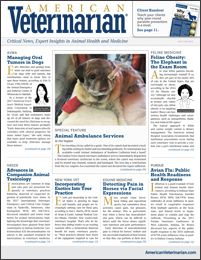Reader Feedback: End-of-Life Care
A letter from one reader regarding a previous article on end-of-life care, and a response from the author.

I read with interest the interview by American Veterinarian® with Dani McVety, DVM, and Mary Gardner, DVM (“End-of-Life Care at Its Best,” June and August 2017). I’d like to thank Drs. McVety and Gardner for their dedication to veterinary medicine and for helping bring end-of-life care to the forefront of our profession. Their revolutionary business model for Lap of Love is an extraordinary gift to clients and to many veterinarians as well. I wholeheartedly agree with many of the points they made.
Their description of budgets was excellent. I often talk to people about these areas (financial, emotional, physical, and time). It is a good reminder, for both veterinarians and clients, to remember that none of us are without limitations, or limited budgets. In terms of convenience euthanasia, I stand with them as well. It is very important to work toward finding the intersection where we find a way to be helpful. As Drs. McVety and Gardner said, judgment is not helpful here; they are absolutely right that in the long run it will harm our profession.
Whose Decision Is It?
Although I agree that as veterinarians we have the right to refuse to perform any euthanasia we are not comfortable with, I am not sure I am being helpful if I insist on euthanizing even if suffering is sustained. The reality is that we cannot legally euthanize without the client’s consent. I have had clients come to me because they refused to allow another veterinarian to euthanize their pet because that person felt there was an unacceptable level of suffering. The client disagreed and, in these cases, so did I. Suffering is subjective, so how do we reconcile what is too much suffering when 2 professionals cannot always agree? As a profession, we should be very careful about believing that our perception of reality is the right one because we are the experts and that clients must follow our direction.
In my experience, the most serious conflict arises when the client doesn’t 100% own the decision. Yes, there is grief and there is often guilt. We really cannot take the guilt away, but we can educate and help the client see that this is a compassionate, realistic, logical, understandable decision. We can explain that we fully support the decision instead of characterizing it in more judgmental terms of right or wrong. We can reassure clients that doubts are normal. And we can remind them that their furry loved one absolutely trusts them and knows their decision is made of love.
Providing Support
Our clients don’t need us to take care of them. They don’t need us to treat them as children who must do as we say. They need us to support them and trust that they are capable of making these difficult life decisions. If they ask for reassurance we can offer it. We serve them best if they reach a place where they can feel a deep sense of peace in making this decision. Holding both guilt and grief is something the heart knows well how to do. It is the head that sees conflict. This is all part of this journey. If we remind clients that self-forgiveness is the healing salve for guilt, we do not have to try to insert our expert opinion as that salve.
Some clients have told me they just knew when it was time. I believe this statement to be true at a very deep level. While it may not resonate with some people, I don’t feel it is fundamentally harmful, at least in my hands. I often say this along with a reassurance that I can be that sounding board if they are not sure. Ultimately and ideally, these clients reach a sense of grounded acceptance and alignment within themselves. The decision regarding euthanasia is not simply a medical one. It is a much more profound existential journey, and most of the time we don’t know even a small portion of the story that is unfolding. We are but supporting actors. What happens if we offer our medical expertise and compassion as partners (rather than the ultimate authority) with our clients while trusting, honoring, and acknowledging that ultimately the decisions are theirs?
I recognize that there is not one best way to do any of this. I also understand that different cultural norms, how well you know the client, personal style, and more will color our experience and our approach. Sometimes it may not go as planned. We too are human, and practicing self-forgiveness is also healthy for us. It is good to continually be willing to question what and how we are bringing ourselves to our work and to life. This is the real, meaningful stuff of life. As Ram Dass said, “We're all just walking each other home.”
Liz Fernandez, DVM, CVA
Acupuncture for Pets Newbury Park, CA

Dr. Fernandez’s words are brilliantly and beautifully stated. She clearly has an incredibly kind, compassionate, and confident way of handling the families she serves. Just as she wrote about us, I wholeheartedly agree with most of the points Dr. Fernandez made in her letter as well.
Insisting Versus Explaining
The statement “insisting on euthanizing” is something I don’t use frequently; I absolutely agree that we cannot and should not make anyone do anything they don’t want to do. The only time I use this phrase is when I’m explaining a state of sustained suffering, such as crying out in pain for more than a few seconds or severe dyspnea, that signals to us as doctors that death is imminent. This is the situation that most people don’t want to be in, which is why they’ve called a service like ours that is dedicated to a peaceful end-of-life experience. And when I gently let a family know that those situations do exist, it helps us partner together to make the best decision we can make. They are informed of what happens if/when we come to a natural passing.
The idea of “making a client do something” should rarely exist in veterinary medicine outside of extreme abusive circumstances. Pets are legal property, so we’re technically not allowed to do anything the family doesn’t approve of.
Leaving Judgment Out of It
What about a pet that is suffering and really should be euthanized? I receive this question from veterinarians 10 times more often than I receive its counterpart (“What if I don’t want to euthanize an animal that I know isn’t ready?”). This appears to be a bigger problem in our industry, which makes sense in my experience. Dr. Fernandez is absolutely right; we don’t always need to step in. Some families have a different journey, and that’s OK! Some clients (and even some veterinarians) tend to think that we absolutely must euthanize a pet for him or her to die. They agonize over “when” while occasionally forgetting that Mother Nature may have a different idea. Sure, we have an epidural to make coming into this world a little less painful, and we have euthanasia to make going out of this world a little less painful, but neither is required for the natural processes of life to occur.
Most of the time, when I’m answering this question with doctors, I’ll give some high-level FBI communication and body language techniques that sound absolutely genius! But at the end of the day, I remind my fellow doctors that we must separate ourselves from the outcome. It’s OK to be kind and loving to a family that just can’t let go. Forcing them will be more detrimental to their experience with their pet than allowing a natural passing, even if they regret it afterward (which is commonly the case). Death will come eventually whether we intervene or not. And in the end, after the experience has settled, we want the family to feel supported—not judged, not made to do something, and certainly with as little regret as possible.
“Suffering” is subjective and always will be. When it comes to end-of-life care, I define suffering as the inability to physically or mentally do anything other than address the pain being experienced. This includes patients that are cyanotic and dypsneic, laterally recumbent and nonresponsive, and/or consistently crying out in pain. “Suffering” may or may not be sustained, and it is the number one thing my clients want to avoid. Giving a good definition of this word coupled with an appropriate potential death process per their pet’s disease is essential to helping the family prevent suffering. It’s also helpful to remember that euthanasia isn’t just about stopping suffering that is occurring at that moment, but also preventing it from occurring in the first place.
Speaking to Clients
I agree that the statement “you will know when it is time” is not fundamentally harmful. And yes, for some clients who need that vote of confidence, I will go down that road. In my experience, and particularly when asking veterinarians about their own experiences with their personal pets, 1% to 5% will agree with the statement, “I knew when it was the right time.” When it is said, we most often hear it postmortem, however, which certainly makes sense; hindsight is so clearly 20/20.
“You’re doing the right thing” is a phrase I have removed from my end-of-life vocabulary and replaced with, “We are doing the best thing.” I completely agree with you that clients should partner with us in the decision. Clients should not feel that it’s completely on their shoulders. Any time I hear a family say “I’m killing my best friend,” or, “I can’t believe I’m doing this,” I respond with, “I’m the one who gives the injection, and I wouldn’t do it if I didn’t believe it was the very best decision we can make.” I need them to know that I take my work very, very seriously and that I believe in what I do. They always, and I mean always, thank me for it. I see their shoulders relax, their voices soften, and they seem to open up to me more when I lift the guilt that “they” are doing something during a euthanasia. Yes, they are left with their grief, but their guilt has, hopefully, been mitigated.
Directing the Effort
Are we supporting actors? Or the lead actor? Or perhaps the director? This is a question I’ve pondered for a while now. Our first talks on euthanasia were titled “The Art of Euthanasia.” They were presented in way that illustrated this important appointment as an orchestrated experience for the client, with every little detail tended to from the first phone call to the walk back out to the car. I personally see this role as a director, the one who confidently and gently ushers the group through the appointment. All other parties are willingly there, trusting the director’s decisions, ideally because that trust has been earned. And any outcome ultimately lies (generally speaking) on the director’s shoulders.
Dani McVety, DVM
Founder, Lap of Love Veterinary Hospice Tampa Bay, FL
